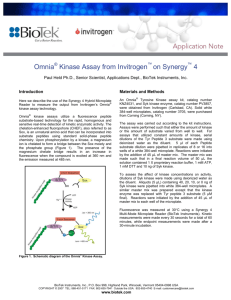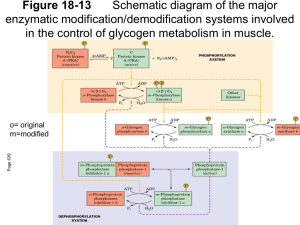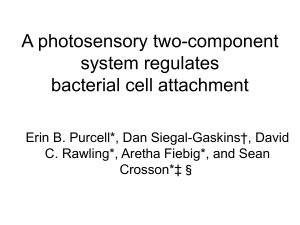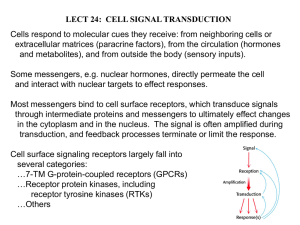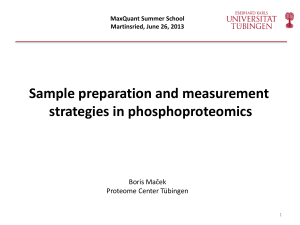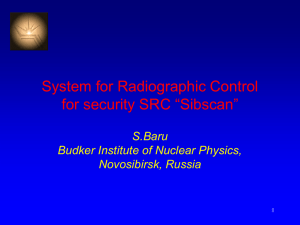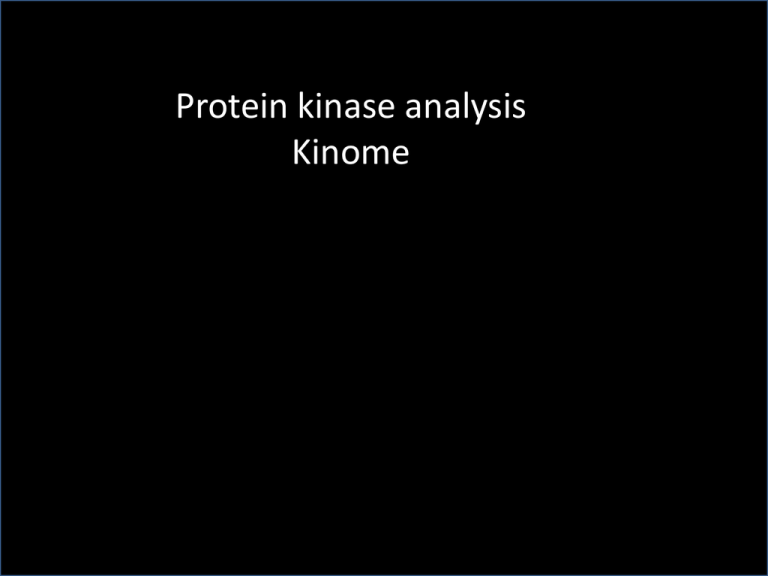
Protein kinase analysis
Kinome
Intracellular Signal Transduction
G protein-coupled
receptor
G
AC
G
PLC
Ca2+
cAMP
DAG
Ras
CaM
PKA
Sos
Pi
CaMK
PKC
Pi
Pi
Pi
MEK
Pi
C-Myc
CREB
Pi
ERK
Apoptosis
Casp-3
Smad
STAT
Pi
Pi
Cyt-c
GSK3
Adhesion
Extension
JAK
Pi
Ser/Thr kinase
receptor
Pi
FAK
Bad
Apaf-1
Pi
PI3K
PKB
Bcl-2
Casp-9
Grb2
Raf
Pi
Pi
ELK
Transcription
Tyrosine kinase
receptor
Glycogen
synthesis
Cytokine
receptor
Protein kinases
Protein kinases
P
+ ATP
+ ADP
1)ca. 500 kinds of putative kinases are coded in human genome
2) 1/3 of whole proteins are phosphorylated.
3)Certain protein kinase is hyper-activated in particular
diseases, such as cancers, cardiovascular diseases
Protein kinase signaling will be crucial target
in diagnostics and drug discovery
Disease cells and hyper-activated protein kinases
Cancer:Protein kinase Cα, Src, Akt, ALC, c-Met
Inflammation:I-κ-kinase
Cardiovascular diseases:Rho kinase, Src
Diabetes:Protein kinase Cβ
Assay of protein kinase activity by using fluorescence polarization
a)
Protein kinase
Aqnti-phospho antibody
P
P
Fluorescence-labeled peptide
Increase of the fluorescence
polarization
b)
P
P
Protein kinase
P
P
+
Protein substrate
Increase of the fluorescence polarization
Assay of protein kinase activity by using FRET
a)
FRET
P
Protein kinase
GFP
Anti-phospho antibody
GFP
Tb
Tb
P
GFP
Time-resolved fluorescence assay
using GFP fluorescence
b)
quencher
FRET
fluoreophore
Protein kinase
P
elastase
P
Quenching of the fluorescence
Non-fluorescent
elastase
Recovery of the fluorescence
Other protein kinase assay
a-Screen Assay
hn
1O
2
P
GST
Moesine
LRRK2
Donor bead
GST
Moesine
Acceptor bead
P
Moesine
GST
QTL assay
Quencher
O
Ga
O
P
Protein kinase
Ga
n
N
O
O
N
CO 2CO2 CO 23+
Ga
CO 2-
Quenching of the bead due to FRET with the quencher
H
N
l
N
m
O
H
N
N
n
l N
H
O
Fluorescent probe for protein kinase using D-RECS strategy
N
N N
Polycation with
substrate
O-Na+
O
O
H
N
m
O
HN
O
N ALRRASLGW
H
NH
S
NH2
Polyanion labeled
with fluoresceine
LPEI-KS10.3
(l = 79.6, m = 10.3, n = 10.1)
H
N
l N
H
O
O
N
H
O- Na+
pAsp-F3.7
(l = 91.8, m = 4.5, n = 3.7)
HN
O
O
n
O
O
H
N
m
O
O-Na +
O
pAsp-F1.1
(l = 97.2, m = 1.7, n = 1.1)
n
O
HN
NH
O
O
+ Na-O
Polyion complex
(quenching)
O
O
Recovery of fluorescence
+Na -O
LPEI-Kemp10.3-S/pAsp-F3.7
1.00
0.80
0.60
0.40
0.20
0.00
0
2
4
C/A
6
8
Relative Fluorescence Intensity
Relative Fluorescence Intensity
LPEI-Kemp-S10.3/pAsp-F3.7=3.0
1.20
H
N
0.35
0.30
l
N
N
m
n
0.25
0.20
PKA (+)
0.15
PKA (-)
0.10
Inactivated PKA
0.05
0.00
0
20
40
Time (min)
60
80
N
N N
O
N ALRRASLGW
H
LPEI-Kemp-S10.3
(l=79.6, m=10.3, n=10.1)
LPEI-KS10.3
(l = 79.6, m = 10.3, n = 10.1)
O-
Protein kinase assay using Au nano-particle
Phosphorylated substrate
Substrate peptide
Detection of PKCα activity in tumor tissue
OD
Phosphorylation ratio
0.3
100
Phosphorylation ratio
(%)
A
Normal (skin)
0.25
0.2
OD
inhibitor(mM)
0.15
Tumor(B16)
80
60
-
-
0.5
40
0.1
5.0
20
0.05
0
Tumor
pPKCα
actin
0
Normal
4%
70 %
33 %
tumor
0%
normal
p-PKCa
Normal tissue
tumor tissue
actin
0.3
B
0.25
Tissue lysate
OD
0.2
0.15
0.1
0.05
Detected with Au-particle system
0
0
0.5
5
Inhibitor concentration (μM)
Inhibitor (Ro-31-7549)
Tumor Normal
Application to breast cancer prognosis
P < 0.05
Normal
0.3
0.3
OD @OD670nm
0.25
Breast cancer
(18 samples)
Normal tissue
(12 samples)
Lysis of tissues
0.2
0.2
0.2
0.15
0.15
0.1
0.1
0.1
0.05
00
High
Middle
Low
Middle
(6)
0.05
High0
(6)
tumor
Tumor
PKCa was detected with the assay
Biosensors Bioelectronics, 2010, 25, 1869.
Low0.3
(6)0.25
0
5
10
normal
Normal
15
20
Evaluation of kinase inhibitors
p38 inhibitor (SB202190)
SB 202190 (nM)
3000 1000
Protein kinse A inhibitors
H-89
100
30
10
active p38a +
inactive MAPKAPK-2
active MAPKAPK-2
H-89 [mM]
0
300
0.4
30
OD650
0.3
IC50: 125 nM*
0.2
0.1
0.0
10 1
10 2
10 3
10 4
[SB-202190] (nM)
Rottlerin
active p38a + inactive MAPKAPK-2
active MAPKAPK-2
Src inhibitors
IC50: 2.18 mM
OD650
0.35
SU6656
PP2
Y27632
0.25
0.15
0.05
10 1
10 2
10 3
10 4
inhibitor (nM)
J. Oishi et al, Anal. Biochem. 373, 161-163 (2008)
Screening of PKA inhibitors
1
2
3
4
5
6
7
8
9
10
11
12
13
14
15
16
Candidates found by the assay -IC50-
Each compound was added in 0, 10, 30, 100, 300, 1000, 3000, 10000 nM to MCF-7
lysate, respectively and after the phosphorylation reaction, Au-particle dispersion
was added to the reaction mixture.
No.
Name
IC50 (nM)
calculated
reported
8
H89
95
144
11
Staurosporine
4.8
7.0
Kinome & Kinomics
Cancer chemotherapy and molecular target drug
1. survival benefit of cancer chemotherapy
Molecular target drug
Drug which is effective only to target cell
When chemotherapy is used with operation, the survival benefit is just 5% for 5 years and
only 1% for 15 years comparing with operation only
→Is cancer chemotherapy really effective?
(Journal of the National Cancer Institute, 98, 1108-17(2006)より )
2. survival benefit of molecular target drug
Two drugs combination(Avastin®+ Erbitax®)for colon
cancer brought about 1.3 months shorter life
expectancy comparing with the conventional
anticancer drug (5-FU+OxPt) administration.
→Is molecular target drug also effective?
(New England Journal of Medicine, 360, 563-572(2009)より)
3. problem with acquisition of resistance
Some tumors acquire a resistances against molecular targeted drug with repeated
administration. However, its mechanism has not been clarified.
2/10
Pathways in
Human Cancer
From R.A. Weinberg
Appendix: The
Biology of Cancer
(Garland Science
2007, Taylor &
Francis)
19
20
TK・・・tyrosine kinase
TKL・・・tyrosine kinase like
STE・・・homologs of yeast sterile 7,11,20
CK1・・・casein kinase-1
AGC・・・members of protein kinase A, G, C families
CAMK・・・Ca+ calmodulin-dependent protein kinases
CMGC・・・containing CDK, MAPK, GSK-3 and CLK families
Human Kinome
22
From R.A. Weinberg: The Biology of Cancer, Fig.16-12 (Garland Science 2007, Taylor & Francis)
Peptide array for kinome
384 plate:
→ 80mL / assay
Peptide array:
30µL / assay
1/2000分
23
Concept of kinome profiling
Phosphorylation pattern
Cell lysate
Profile A
パターンA
Normal cell
Diagnostics based on the profile
Drug discovery using the profile
Cell lysate
Disease or drug administered cell
パターンB
Profile
B
Commercial available kinome arrays
PepChip Array
Barrett’s esophagus
Each peptide is immobilized in micro-well(50 μL)
1152 kinds of peptides can be immobilized
Detect with 33P-ATP
PamChip Array
Substrates are immobilized on a porous support
Repeat the putting in and out repeatedly to promote
the reaction
green:acive in BE
red:inactive in BE
Detect with 33P-ATP
144 kinds of substrate can be immobilized.
・MAPK signaling was suppressed and glycolytic metabolism
was activated in BE
CelluSpot Array
Each substrate is synthesized on a cellulose membrane (SPOT synthesis)
Radius of each spot: 1.2 mm
Detect with HRP-labeled anti-phosphotyrosine antibody (CL)
384 kinds of peptides can be immobilized.
Our peptide array
H
S
P P P P
NH
O
N
H
H
HN
HN
O O
P
O
O
R
O-
細胞破砕液
N
ON
N
2+
Zn Zn2+
ON
N
N
Phos-tag
Phos-tag
P P P P
P P P P
Cy3-streptavidin
Detect with Microarray scanner
Surface chmistry
Y
Y
P
Y
Phosphorylation
Application to Iressa sensitivity
A549
HCC827
・Highly sensitive
・EGFR kinase with mutation
・Resisitant
・Other pathway is activated.
EGFR
EGFR
iressa
Other receptors
iressa
Akt
ERK
Cell death
Akt
ERK
Cell survive
Protocol
3 nM
300 nM
[Iressa]
HCC827
IC50=16 nM
A549
IC50=30 μM
EGF
15min
Iressa
2 hour
phosphorylation
3 hour
phostag-SA
1000 peptides
lysis
Comparison between A549 and HCC827
HCC827
A549
Tyr peptide
Ser/Thr peptide
iressa 300 nM
iressa 300 nM
Tyr peptideのうち良く反応
Iressa(-)
Iressa(-)
・Iressa inhibited the phosphorylation of many substrate in HCC827.
Alternative pathway is Src-pathway?
A549
HCC827
Src
EGFR
iressa(+)/iressa(-)
iressa(+)/iressa(-)
EGFR
target
peptide no.
Src
9
EGFR
183
EGFR
264
EGFR
345
Src
657
Src
661
Abl
669
Src
Src
Src
Src
Src
822
1062
1144
1148
1228
Src
<Kinome Profile modification with metformin > (Dr. Osamu Okitsu)
activation
4 .0 0 0
2 .0 0 0
0 .0 0 0
- 2 .0 0 0
suppression
1 ← peptide No. → 557
- 4 .0 0 0
1
51
101
151
201
251
301
351
401
451
501
551
No
<Drug A>
activation
4 .0 0 0
2 .0 0 0
0 .0 0 0
- 2 .0 0 0
1 ← ペプチドID番号 → 557
suppression
- 4 .0 0 0
1
51
101
151
201
251
301
No
351
401
451
501
551

